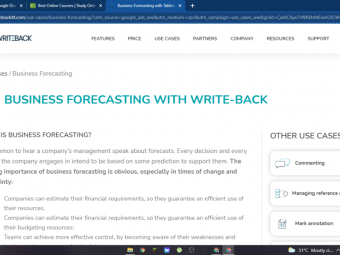Media Planning
Tags: Advertising Strategy
Kick Start your Media Planning Course
Last updated 2022-01-10 | 4.2
- media planning- brand strategy
- Digital Advertising
What you'll learn
* Requirements
* Working Experience in AdvertisingDescription
Media Planning is an art of selecting & strategizing the best combination of Media in-order to maximize the best returns to your advertiser. Media planners are not only responsible for the initial media purchase, but also for the continued optimization of performance throughout the entire campaign life cycle. In this course you'll learn about How to create a successful media plan for your advertiser from scratch.
Who this course is for:
- Advertising aspirants
- working professionals in advertising
- Campaign Managers
- Ad operations
- Media Planners
Course content
4 sections • 9 lectures
Introduction Preview 01:11
Welcome to the course Media Planning.
Today we will talk about
Media Planning Introduction
Key Campaign essentials
What's fits where – here we will talk about Formats and relative KPIs
Inventory – ways to buy certain inventory
Media Mix & sell rates – here we will talk about budget allocations across strategies/ formats and their rationales behind them.
Next we will talk about the most important aspect that is – Target Audience
See you in the next video!
What is Media Planning? Preview 03:13
Hi Welcome back to Chapter - 1
What is Media planning?
Media planning is the process of strategizing and purchasing ad placements by determining the best combination of media to achieve marketing campaign goals. The media plan might split advertising spend and resources between various online and offline channels such as broadcast, print, Display ads, video ads or native content.
You might ask --
What's the need of a Media Plan?
In today’s competitive marketing landscape, marketers need to serve users with the right message, at the right time, on the right channel in order to see engagements. That’s why there is a dire need of an effective media plan which helps the advertiser to reach the potential user at the right place and at the right time without missing an opportunity.
While create media plans, lot of times I heard different myths about Media planning so I thought I would share few of them with you today -
Myths of Media Planning –
Two media plans would be same –
The Truth is no two media plans would be the same because there isn't any fixed approach to create a media plan but there are only best practices. There could be multiple ways you can reach the same user, so ideally it all depends on your rationale behind selecting each element in your media plan.
A perfect Media plan = reaching goals –
the truth is, a perfect media is only a first step in reaching the goals/ KPIs, while the next steps would be effective optimizations which would give the final results.
Media plans should have few/ specific formats –
a lot of times when people ask me should we include certain formats or certain types of inventory, I would always say there are no mandatory formats which YOU should ideally be including but It depends more on how your formats are complimenting each other in-order to achieve the end result.
So don't worry about these things while you create a media plan.
See you in the next video!
Key Campaign Essentials Preview 02:38
Hi Welcome back to Chapter - 2
Before we start on with the essentials, let me tell you a story -
My mom once gave me $100 and handed me a list of items to prepare a dish (banana cake) over the weekend.
She said, get me a few top quality and highly recommended ingredients to bake a banana cake.
So as a first step
I researched about what are the best ingredients I should buy for baking a banana cake
Next, I listed out stores where I can buy them, after listing out stores, I would check prices in each of the store without compromising the quality of the product
Once I made a list of all stores nearby and finalized the best rates. I filtered what ingredients should be bought from which store.
All this I have to do before the weekend.
I hope this story is relatable and simple, Media planning is pretty similar, let me relate this story to media planning.
My mom told me she wanna prepare a banana cake - this is the goal (you can call it Business Goal)
My mom also handed me $100 which is the BUDGET
Next I listed out stores from where I can buy these ingredients, in advertising space, these stores are your publishers (could be print, offline, online media sellers)
And then we have a timeline - which is your campaign flight dates.
Finally Audience - well the audience here is everyone who enjoys the delicious banana cake.
Please remember this story and we would be linking this story in every step of Media planning moving forward.
So the key campaign essentials are
Business Objectives
Budget
Flight Dates
Target Audience/ Geo
See you in the next video!
Understanding KPIs & Business Goals Preview 02:31
Hi Welcome back to Chapter - 3
Whats fits Where?
We have several formats in the advertising space, be it Audio, Video, Display, Connected TV, Print, Native and so on.
And we have different goals related to costs like CPM, ROI, CPA and others while there are several other performance goals like Click Through Rate, Viewability, completion rate and several others.
So how do we know which one to choose and what fits where?
So going back to the story, we were able to get the ingredients only because we know the dish. In the same way, we will be able to select KPIs and formats when we know a business Goal.
Lemme share couple of examples
Example 1 -
if there is a Car advertiser who is a new entrant into the market, it would be wise to choose a Video Format Advertising preliminary focusing on completion rate.
This is because, Video is an excellent format for informing and educating the user. Because it incorporates audio and visual elements that appeal to multiple senses, the user can get the full story of your product.
They’re especially effective when used for product demonstrations or explaining about the uniqueness of your product.
Example - 2
If there is an established product in the market, trying to increase sales, then it would be wise to choose Native or Display content with focus on clicks and then Conversions.
As the brand is not relatively new and it already penetrated into the market, you can shift your KPIs related to sales.
To create a successful media plan you need to understand the business objectives and pick the relative formats and KPIs as we can't measure the effectiveness of a media plan unless we set clear goals from the start!
See you in the next video!
Finding the Best Inventory/ Publishers Preview 02:15
Hi Welcome back to Chapter - 4
Inventory
There are several Media Sellers available in the market, it could be print, online & offline media.
For example - if we look at online media, there are OTT platforms like Disney Hotstar, Prime video while we have video streaming sites including DailyMotion, Youtube and others.
If we look at Audio, we have Soundcloud, spotify, Gaana, tunein and others and for display and video we have millions of sites.
Now we’ll have to figure which media publishers to include in the Media plan.
Let me share some examples -
If your advertiser is related to the entertainment industry, then it would be wise to choose Audio/ Video publishers related to the entertainment industry.
If your brand is related to Automobiles, then it would be wise to choose or advertise on shows which are related to Automobiles or on web pages which talks about Automobiles.
It wouldn’t be wise to advertise Automobiles on sites with content about relationships. So we need to carefully curate shows, content, sites which are in the interest of the advertiser.
Once the analysis of the business objectives is complete, make sure you dig deep into the publisher space to determine which media channels will be our best bet in reaching our business goals.
Once the selections of publishers is done, always ask yourself
If this is the best media mix?
Explore all ranges of publishers to see which Media caters the best for the advertiser.
Media Mix & Sell Rates Preview 01:53
See you in the next Video!
Hi Welcome back to Chapter - 5
Media Mix & sell Rates
Now that we’ve selected the formats & publishers, we will now have to decide on what media mix or budget we're gonna allocate to each of the formats that we are using.
One of the ways to reach a perfect media mix is by understanding the target audience and ways to reach them.
Example 1 - If the Product is more related to a younger audience, it would be wise to allocate more budget towards advertising in smart devices and also allocating more budget in Urban areas of your target region as this can help the advertiser to drive more sales.
Example 2 - If the brand is particularly new to the market, then we can allocate 60-70% of the budget on Video Advertising focussed on creating Brand Awareness, while the rest of the budget can be used for Remarketing.
Here are some questions to ponder!
Can we reach the target Users with the budget share? - we need to have forecast reach so that we don't have any pacing issues.
Does the Brand have any budget split preference? (Geo, Format) - always ask your Advertiser as they know the product better.
Taking Historical CPM's to estimate the Costs? - This will help you to understand the bids, in case if you're in business where you will make a margin out of your campaigns, understanding CPMs would be very important as this would affect your margin.
See you in the next Video!
Audience Preview 10:35
Hi Welcome back to Chapter - 6
Audience -
Marketing today is driven by creating positive user experiences and there are countless ways to reach users in this world, but the key is knowing which ones are the best for your specific campaign.
Knowing what to advertise is creativity but understanding whom to advertise is the real science of advertising. Understanding who to reach with your media plan starts with defining your target audience.
Here are some things to consider when building the target audience for your campaign:
Type of advertising message– Business to Business (B2B) or Business to Consumer (B2C)
Demographics – age, gender, ethnicity, income, occupation, etc
Interests – intent to purchase, in-market
For example -
Lets say we have an advertiser with product of platinum engagement rings, so when we look at the product, we understand the following -
Probable Target Audience would ideally be from age 25-35 (Gender being both male & female) because people are mostly likely to get married in this age bracket.
Since they are expensive, we need to target HHI or users with a high income source or group as not everyone can afford these expensive rings.
Geo - Urban areas/ cities, as this area would drive higher sales compared to remote & rural areas.
Example 2 -
If the advertiser has a affordable product jewelry related to female (nothing related to marriage), then the following would be the probable audience
Target Female 18+
Since they are affordable, we can target any users who are interested in Jewelry, Fashion, ornaments, designer wear buyers and so on.
Here Geo could be open, it necessarily doesn't have to be restricted to Urban areas or metropolitan cities but could be open as they are affordable.
If we look at both the examples, the product line might look similar but the targeting is completely different. So we need to carefully understand the product so that we can find the most relevant audience.
This brings us to the last lecture on Media planning and see you in the next video which is Case Study.








 This course includes:
This course includes:















